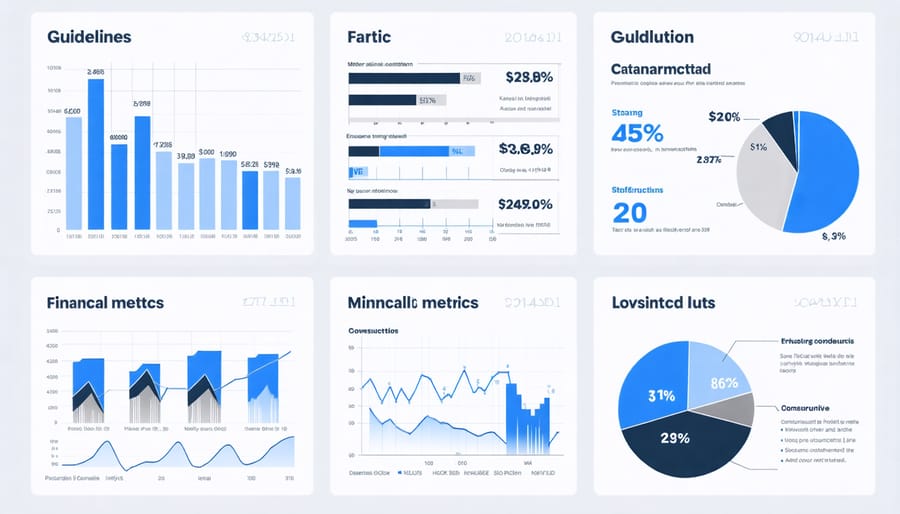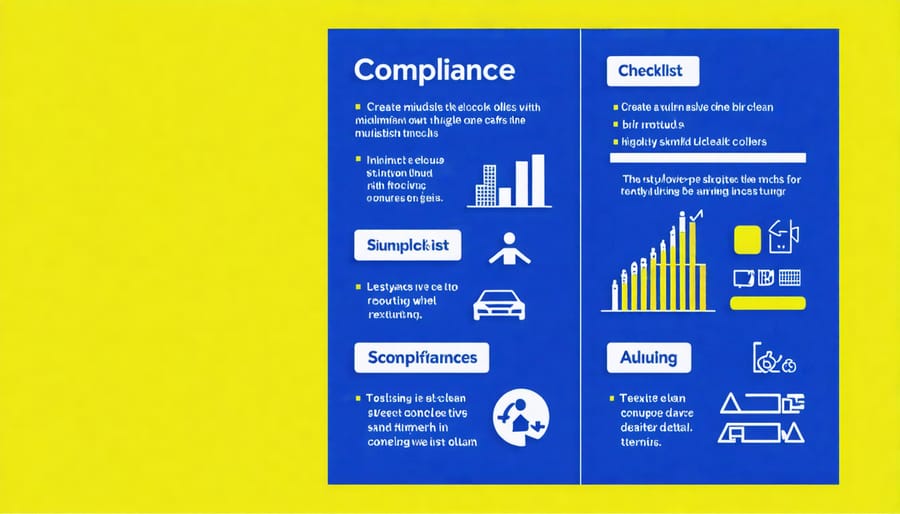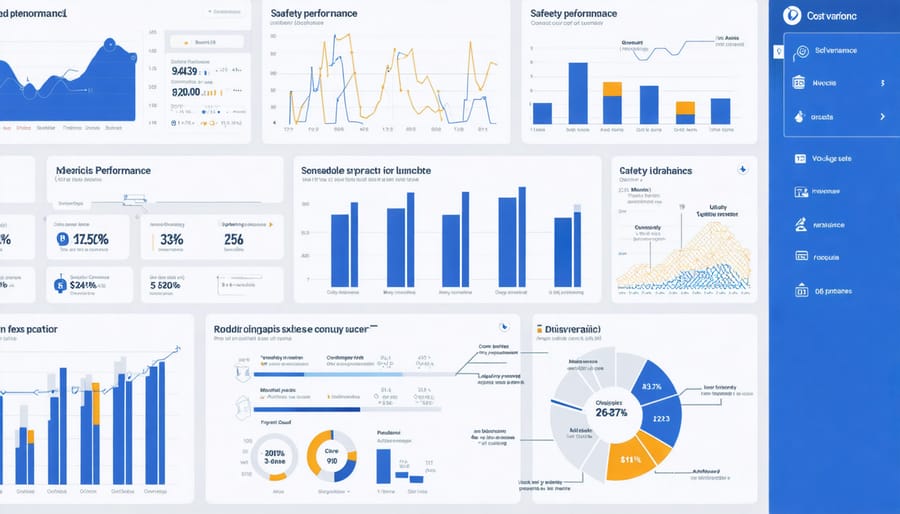In today’s competitive construction landscape, measuring the right metrics stands as the fundamental difference between project success and costly setbacks. Construction leaders leveraging data-driven decision making consistently outperform their peers by 20-30% in project delivery times and cost efficiency. The industry’s rapid digital transformation has made it crucial for organizations to track, analyze, and optimize key performance indicators across safety, productivity, financial health, and project execution.
Yet, with over 700 possible construction metrics available for tracking, many organizations struggle to identify and implement the most impactful measurements for their specific needs. This comprehensive guide breaks down the essential metrics that drive successful construction projects, provides frameworks for effective implementation, and offers practical insights from industry leaders who have mastered the art of performance measurement. Whether managing a single project or overseeing multiple construction sites, understanding these critical metrics will transform how you evaluate, predict, and improve project outcomes.

Financial Performance Metrics
Cost Variance and Budget Performance Index
In construction project management, effective cost variance analysis and budget performance tracking are crucial for maintaining financial control. The Cost Variance (CV) metric measures the difference between the budgeted cost of work performed (BCWP) and the actual cost of work performed (ACWP), providing immediate insight into project spending efficiency.
The Budget Performance Index (BPI), calculated by dividing BCWP by ACWP, offers a ratio that indicates cost efficiency. A BPI greater than 1.0 suggests the project is under budget, while values below 1.0 indicate cost overruns. Industry standards typically aim for a BPI between 0.95 and 1.05 to maintain acceptable cost control.
To effectively implement these metrics, project managers should:
– Monitor costs in real-time using integrated project management software
– Review variances at predetermined milestones
– Establish clear threshold limits for acceptable variances
– Document root causes of significant deviations
– Implement corrective actions promptly when variances exceed thresholds
Leading construction firms regularly analyze these metrics to identify cost-saving opportunities and prevent budget overruns. By maintaining detailed cost records and conducting regular variance analyses, project teams can proactively address financial challenges before they impact project success. This systematic approach to cost monitoring has become increasingly important as construction projects grow more complex and profit margins tighten.
Return on Investment (ROI) and Profit Margins
Return on Investment (ROI) and profit margins are critical indicators that measure the financial success of construction projects. The construction industry typically aims for net profit margins between 2% and 10%, with variations depending on project type, size, and complexity. To calculate ROI in construction projects, divide the net profit by the total project investment, then multiply by 100 to get the percentage.
Several factors influence these profitability metrics, including direct costs (materials, labor, equipment), indirect costs (overhead, insurance, permits), and project efficiency. Successful contractors often maintain detailed cost tracking systems to monitor these elements throughout the project lifecycle.
A comprehensive profit analysis should consider:
– Gross profit margin (revenue minus direct costs)
– Operating profit margin (revenue minus both direct and indirect costs)
– Net profit margin (final profit after all expenses and taxes)
Industry benchmarks suggest that high-performing construction companies maintain operating margins above 8%, while the industry average hovers around 5%. However, these figures can vary significantly based on market conditions and project specialization.
To optimize ROI, construction firms should:
– Implement robust cost control measures
– Monitor and reduce waste in materials and labor
– Utilize value engineering when appropriate
– Maintain efficient project scheduling
– Leverage technology to improve productivity
Regular analysis of these metrics enables companies to make data-driven decisions and identify areas for improvement in project execution and financial performance.
Project Efficiency Metrics
Schedule Performance Index
The Schedule Performance Index (SPI) is a critical metric in project efficiency tracking that measures the relationship between work completed and work planned at any given point in time. Calculated by dividing the Earned Value (EV) by the Planned Value (PV), an SPI greater than 1.0 indicates the project is ahead of schedule, while values below 1.0 signal schedule delays.
Construction managers utilize SPI alongside other performance indicators to maintain precise control over project timelines. The metric provides early warning signs of schedule slippage, enabling proactive intervention before delays become critical. For example, if a project’s SPI drops to 0.85, it suggests that work is progressing at only 85% of the planned rate.
To effectively implement SPI monitoring, projects require:
– Regular progress updates and accurate work completion data
– Detailed baseline schedules with clear milestones
– Consistent measurement methodologies
– Integration with project management software
Industry best practices recommend weekly SPI calculations for large-scale projects and monthly assessments for smaller developments. This frequency allows teams to identify trends and implement corrective actions promptly. When combined with Cost Performance Index (CPI), SPI provides a comprehensive view of project health, enabling data-driven decisions about resource allocation and schedule recovery strategies.
Labor Productivity Rates
Labor productivity rates measure the efficiency of workforce output, typically expressed as work hours per unit of completed work. These metrics are crucial for estimating project costs, scheduling, and evaluating crew performance. The most common measurement approach is units per labor hour (UPH), which tracks how many units of work (such as square feet of drywall installed or cubic yards of concrete placed) a crew can complete within one labor hour.
Construction managers use productivity rates to establish baseline performance standards, identify efficiency gaps, and implement improvement strategies. Factors affecting labor productivity include weather conditions, site access, material availability, crew skill levels, and equipment effectiveness. Regular monitoring of these rates helps detect trends and anomalies that might impact project timelines and budgets.
Industry benchmarks suggest that optimal labor productivity can reduce project costs by 10-30%. However, productivity rates vary significantly across different trades and project types. For instance, commercial building projects typically achieve different rates than infrastructure projects due to varying complexity levels and working conditions.
To maximize workforce efficiency, successful construction firms implement systematic productivity tracking systems, provide regular training programs, and utilize advanced planning tools. Real-time productivity monitoring through digital platforms enables immediate intervention when rates fall below expected levels, ensuring projects stay on schedule and within budget constraints.


Safety and Compliance Metrics
Incident Rates and Safety Scores
Safety performance in construction projects is measured primarily through incident rates and comprehensive safety scores. The Total Recordable Incident Rate (TRIR) and Days Away, Restricted, or Transferred (DART) rate serve as key indicators for evaluating adherence to workplace safety standards. Industry leaders typically maintain a TRIR below 3.0 and DART rate under 1.5, setting benchmarks for excellence in safety performance.
Experience Modification Rate (EMR) directly impacts insurance premiums and project qualification, with scores below 1.0 indicating better-than-average safety performance. Leading indicators such as near-miss reports, safety training completion rates, and jobsite inspection scores provide proactive measures for preventing incidents before they occur.
Construction firms should implement a robust safety metrics dashboard that tracks both lagging and leading indicators. Regular analysis of these metrics enables companies to identify trends, address potential hazards, and maintain continuous improvement in their safety programs. Successful organizations typically review safety metrics monthly and adjust their protocols based on data-driven insights.
Compliance Achievement Rates
Compliance achievement rates serve as critical indicators of a construction project’s adherence to regulatory requirements and industry standards. These metrics typically track the percentage of successful inspections, completed certifications, and regulatory compliance across various project phases. Industry benchmarks indicate that high-performing construction companies maintain compliance rates above 95%, while the industry average hovers around 85%.
Key components of compliance tracking include safety regulations adherence, environmental compliance, building code conformity, and certification status maintenance. Project managers should monitor both leading indicators, such as pre-inspection preparation rates, and lagging indicators, such as final inspection pass rates.
To effectively measure compliance achievement, organizations should implement systematic documentation processes and regular audits. Digital compliance tracking systems can significantly improve accuracy and provide real-time monitoring capabilities. Construction firms should pay particular attention to trends in violation patterns and recurring non-compliance issues to develop targeted improvement strategies.
Success in maintaining high compliance rates often correlates with reduced project delays, lower insurance premiums, and enhanced reputation among stakeholders. Regular reporting and transparent communication of compliance metrics help maintain accountability and drive continuous improvement in regulatory adherence.
Quality Control Metrics
Defect and Rework Rates
Defect and rework rates serve as critical indicators of construction quality and project efficiency. Industry research indicates that rework typically accounts for 4-12% of total project costs, making it essential to track and minimize these occurrences. Quality-related metrics should focus on both the identification and resolution of defects throughout the construction process.
Key performance indicators in this category include the First-Time Quality (FTQ) rate, which measures the percentage of work completed correctly on the first attempt, and the Defect Rate per Unit Area, typically expressed per 1,000 square feet. Construction firms should also monitor the Cost of Quality (CoQ), encompassing both prevention expenses and failure costs.
Successful organizations implement systematic defect tracking systems that categorize issues by severity, location, and trade responsible. This data enables teams to identify patterns, implement preventive measures, and improve quality control processes. Leading construction firms maintain defect rates below 2% of total work completed and achieve FTQ rates above 90%.
Real-time monitoring through digital quality management platforms has revolutionized defect tracking, allowing for immediate identification and resolution of issues. These systems often integrate with project management software, creating a comprehensive quality control ecosystem that reduces response times and improves accountability.
To optimize performance, companies should establish baseline metrics, set improvement targets, and regularly review quality data with project teams and subcontractors. This proactive approach helps prevent recurring issues and reduces the financial impact of rework.
Client Satisfaction Scores
Client satisfaction scores represent a crucial metric in evaluating project success beyond traditional performance indicators. These scores provide valuable insights into how well construction teams meet or exceed client expectations, ultimately influencing future business opportunities and industry reputation.
Construction firms typically measure client satisfaction through structured surveys administered at key project milestones and completion. These assessments evaluate multiple factors, including communication effectiveness, quality of workmanship, adherence to schedules, budget management, and problem-resolution capabilities.
Industry best practices recommend using a standardized scoring system, often on a 1-10 scale, across several key performance indicators (KPIs). Critical areas for evaluation include:
– Overall project delivery satisfaction
– Team responsiveness and communication
– Quality of finished work
– Schedule adherence
– Cost management
– Safety performance
– Problem resolution
– Documentation and reporting
Leading construction firms establish benchmark satisfaction scores of 8.5 or higher as their target. Regular monitoring of these scores enables companies to identify trends, address issues proactively, and implement continuous improvement strategies. Many organizations also incorporate client satisfaction metrics into their employee performance evaluations and bonus structures, ensuring alignment between project teams and client expectations.
Real-time feedback mechanisms, such as monthly client review meetings and digital feedback platforms, are increasingly being adopted to capture and address concerns before they impact final satisfaction scores. This proactive approach has shown to improve overall client satisfaction by up to 25% in documented case studies.
Implementation Strategies
Successful implementation of construction metrics requires a systematic approach and careful planning. Begin by establishing a clear baseline for your current performance levels and identifying specific goals for improvement. Select appropriate software tools that integrate with your existing systems and can handle real-time data collection across multiple project sites.
Create a dedicated metrics implementation team comprising representatives from various departments, including project management, finance, safety, and operations. This team should develop standardized data collection procedures and ensure consistent reporting methods across all projects.
Train your staff thoroughly on the new tracking systems and emphasize the importance of accurate, timely data entry. Implementation should occur in phases, starting with pilot projects to identify and resolve potential issues before full-scale deployment.
Establish regular review cycles to evaluate the effectiveness of your metrics program. Monthly reviews for project-specific metrics and quarterly assessments for company-wide performance indicators are recommended. Document all procedures and create clear guidelines for data validation and quality control.
Consider implementing automated data collection where possible, using IoT devices, mobile apps, and integrated project management software. This reduces human error and increases efficiency. Remember to maintain data security protocols and ensure compliance with relevant regulations.
Regular feedback from end-users is crucial for continuous improvement. Adjust your implementation strategy based on practical experience and changing project requirements. Success depends on maintaining consistent measurement practices while remaining flexible enough to adapt to evolving industry standards.
In today’s dynamic construction landscape, implementing a balanced approach to metric tracking is not just beneficial—it’s essential for sustainable success. By monitoring both leading and lagging indicators across safety, financial, operational, and quality dimensions, organizations can make data-driven decisions that improve project outcomes and organizational performance. The key to successful implementation lies in starting small, selecting metrics that align with strategic objectives, and gradually expanding measurement capabilities as systems mature. Organizations should focus on establishing reliable data collection processes, training teams on metric interpretation, and creating actionable feedback loops. Moving forward, construction firms must embrace digital tools and analytics platforms while maintaining focus on the metrics that truly drive value. With proper planning and execution, a robust metrics program can transform project delivery and create lasting competitive advantages in the construction industry.

